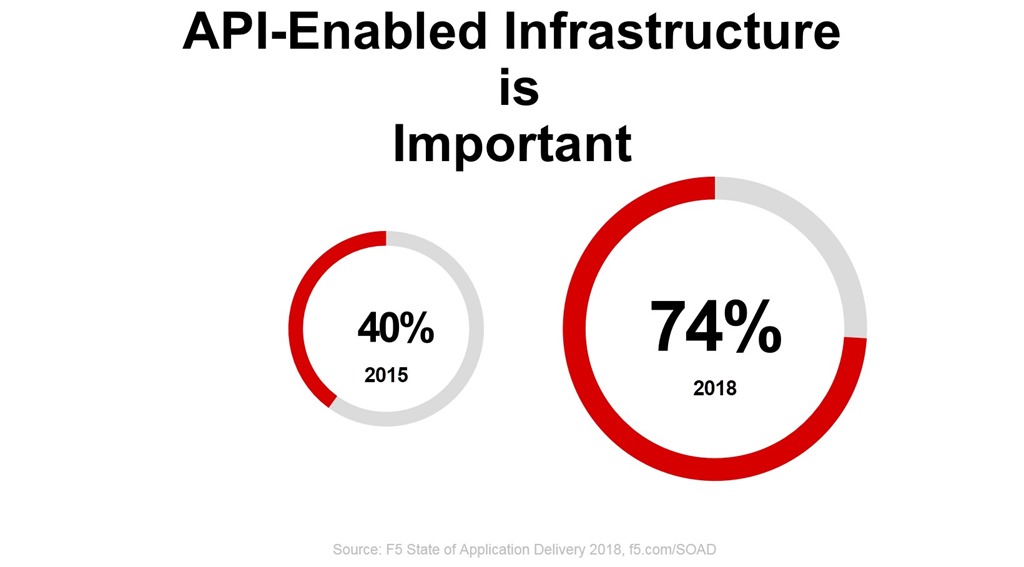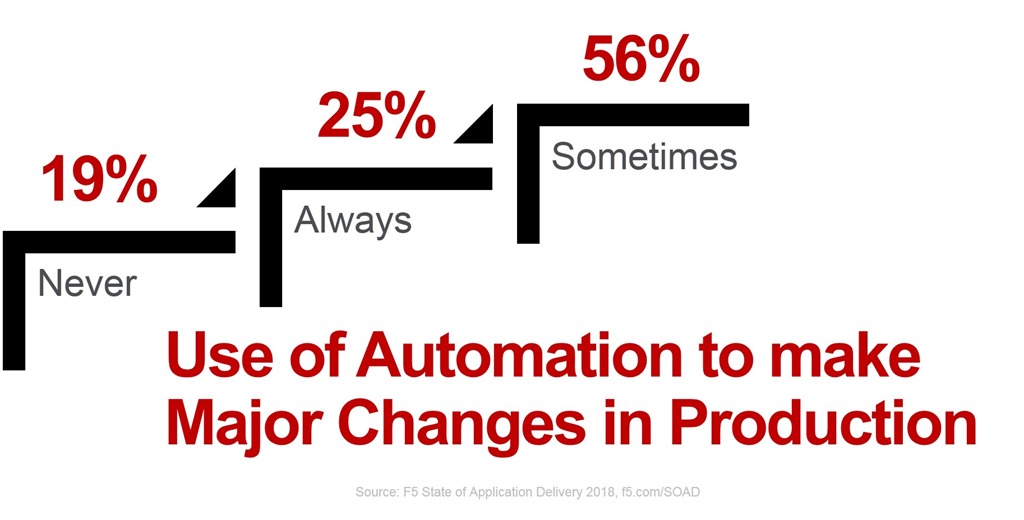2018 年のアプリケーション配信の状況: NetOpsは自動化の波に乗っています

プロトコルやワイヤ キャプチャと同じくらいプログラミング言語を愛する IT の博学者として、自動化とオーケストレーションに必要な 2 つの境界が曖昧になっていることに私は興奮しています。
私たちは 4 年間にわたり、アプリケーション配信の現状に関する調査の回答者が API 対応のインフラストラクチャと関連テクノロジーをどのように認識しているかを追跡してきました。 その間に、インフラストラクチャのプログラマビリティを重要と認識する人の割合(5 段階評価で 4 または 5 のスコア)はほぼ 2 倍になりました。 2015 年には、半分以下 (40%) の回答者が、それが重要であると回答しました。 今年は驚くべきことに 74% がこれを重要だと評価しました。
2017年にこのテーマに関して実施した調査の結果を考えると、これに驚くべきではなかったのかもしれません。 DevOps と NetOps の認識を調査した結果、両グループは、生産パイプラインの自動化が重要であることに一方的に同意しました。
しかし、認識は単なる意見にすぎません。 実際の使用法はまた別の話です。

今年の調査でわかったことは、自動化があらゆる地域、あらゆる業界、あらゆる規模の組織に浸透しているということです。 100% に到達した人はいません (おそらく今後もいないでしょう) が、生産現場では、おそらく誰もが認識しているよりもはるかに多くの自動化が行われています。
実際、回答者の 25% は、生産に大きな変更を加えるときは常に自動化を使用していると回答しています。 60% は、生産に小さな変更を加えるために自動化を使用することがあります。 実際、全体として、インシデント対応よりも生産における変更の方が自動化が使用される可能性が高くなります。 4 人に 1 人以上 (26%) が、インシデント対応に自動化をまったく使用していないと回答し、常に使用していると回答したのはわずか 22% でした。 おそらく予測不可能な出来事への対処における変動性を考えると、これは驚くべきことではありません。 自動化は、明確に定義された一連のタスクと手順を運用プロセスに結び付けることに部分的に依存しています。 これにより、生産における変更(大規模なものでも小規模なものでも)などが、それらのプロセスのコード化に適したものになります。 インシデント対応? あまりないですね。
あらゆる形態、規模、業種のデータセンター内では、非常に多くの自動化が行われているようです。
これらすべての自動化を実装するために何を使っているのか疑問に思うかもしれません。 過去数年間、私たちは多くのツール、ツールセット、フレームワークを 1 つの質問にまとめてきました。 しかし、自動化が実際に定着するにつれて、何が起こっているかを理解するためには、自動化のさまざまな側面を理解する必要があるため、それは合理的ではありません。
1. 言語とツールセット。 これらは、NetOps と IT が自動化のコマンドと制御に使用するものです。 これには、Ansible(20%)やVagrant(5%)などのツールや、Puppet(19%)やChef(16%)などのフレームワークが含まれます。 その中で、明らかに勝者は古き良き Python スクリプトであり、回答者の 39% が IT を自動化するために独自のスクリプトを作成することを選択しました。
2. ネットワークの自動化。 データ パスには平均 16 種類のアプリケーション サービスが存在し、アプリケーションの安全な配信と拡張をサポートするために導入、構成、継続的な管理が必要なため、ほとんどの組織は Cisco ACI (48%)、VMware (65%)、 OpenStack (26%) などのシステムに移行することになります。 これら 3 社はいずれも前年比で大幅な増加を記録しました。 デジタル変革の取り組みの結果として、組織の 55% が自動化とオーケストレーションに移行している環境では、驚くべきことではありません。
3. コンテナ オーケストレーション環境 (COE)。 これらの新興テクノロジーは引き続き大きな波を起こしており、コンテナ化されたアプリケーションの拡張にこれらのテクノロジーを使用することは避けられないようです。 私たちが質問した中では、Docker Swarm が 27% の回答者でトップとなり、続いて Red Hat OpenShift が 21%、Kubernetes が 16% で 3 位につけました。 現時点で何も使用していないと答えたのはわずか 48% でした。
私にとっては驚くことではありませんが、各組織におけるこれらのツールとフレームワークの数は減少しています。 つまり、標準化に向けた戦略的な取り組みの一環として、自動化ツールとツールセットが意図的に使用されていることがわかります。 混乱が広がり、アプリ開発者が長年苦労してきたのと同じ種類の技術的およびアーキテクチャ的負債の重圧に IT 部門が屈する前に、早めに対処したほうがよいでしょう。 実際、回答者の 50% は単一のネットワーク自動化フレームワークのみを使用しています。 そのうち、8% が Cisco ACI、5% が Open Stack、19% が VMware に依存しています。
これはまだ非常に流動的で進化している市場です。これを運動ではなく市場と呼べるのであればの話ですが。 DevOps アプローチの生産への導入とビジネスからのプレッシャーにより、IT の動きが加速しています。 NetOps は自動化とそれに伴うすべてのものを採用し、受け入れています。 IT 部門がデジタル変革の取り組みを継続し、新しいアプリを構築して新しい機会を模索するための強固なデジタル基盤を企業に提供するにつれて、自動化の利用がさらに拡大すると予想されます。
デジタル トランスフォーメーション、マルチクラウド、アプリケーション サービス、セキュリティ、そして継続的な NetOps トランスフォーメーションに関する詳細な情報については、2018 年のアプリケーション配信の現状レポートを入手し、Twitter で@f5networksやハッシュタグ#soad18をフォローしてください。 今後のブログでは、レポートに記載されていないデータや視点を含む、さらに多くの洞察をお伝えする予定ですので、どうぞお楽しみに。
